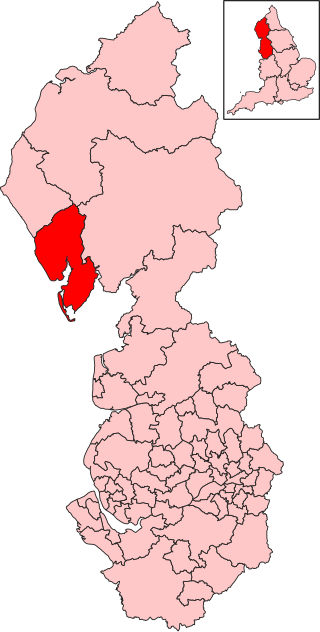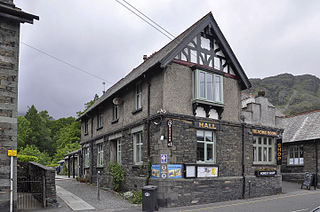External links
- Millom Heritage and Arts - official site
- Entry in the 24 Hour Museum
- Visit Cumbria information
- Millom information website
- The Cumbria Directory - Millom Folk Museum
54°12′40″N3°16′16″W / 54.2110°N 3.2710°W
Millom Heritage and Arts Centre, formerly known as the Millom Folk Museum and Millom Discovery Centre, is located in Millom, Cumbria, England. The museum has a full-scale drift mine exhibit and also houses information about the local poet Norman Nicholson, the Hodbarrow iron ore mines and social history all relating to Millom and nearby surrounding areas. The mining being responsible for the rapid growth of the village of Holborn Hill into the town of Millom by more than doubling the size of the settlement. It now has a RAF display, set up by the original founder of Haverigg RAF Museum, John Nixon. It also shows the men who died in World War 2 and has information about them
The museum is housed in Millom railway station buildings.
54°12′40″N3°16′16″W / 54.2110°N 3.2710°W

Cumberland is a historic county in North West England. The historic county is bordered by Northumberland to the north-east, County Durham to the east, Westmorland to the south-east, Lancashire to the south, and the Scottish counties of Dumfriesshire and Roxburghshire to the north. The area includes the city of Carlisle, part of the Lake District and North Pennines, and the Solway Firth coastline.

Millom is a town and civil parish on the north shore of the estuary of the River Duddon in southernmost Cumberland, Cumbria, England. It is situated just outside the Lake District National Park, about six miles north of Barrow-in-Furness and 26 mi (42 km) south of Whitehaven.

The Borough of Copeland was a local government district with borough status in western Cumbria, England. Its council was based in Whitehaven. It was formed on 1 April 1974 by the merger of the Borough of Whitehaven, Ennerdale Rural District and Millom Rural District. The population of the Non-Metropolitan district was 69,318 according to the 2001 census, increasing to 70,603 at the 2011 Census.

The Langdale axe industry is the name given by archaeologists to a Neolithic centre of specialised stone tool production in the Great Langdale area of the English Lake District. The existence of the site, which dates from around 4,000–3,500 BC, was suggested by chance discoveries in the 1930s. More systematic investigations were undertaken by Clare Fell and others in the 1940s and 1950s, since when several field surveys of varying scope have been carried out.

Norman Cornthwaite Nicholson was an English writer. Although he is now known chiefly for his poetry, Nicholson also wrote in many other forms: novels, plays, essays, topography and criticism.

Barrow and Furness, formerly known as Barrow-in-Furness, is a UK Parliament constituency in Cumbria. It has been represented in the House of Commons of the UK Parliament by Michelle Scrogham of the Labour Party since 2024.
Haig Colliery Mining Museum was a visitor attraction in Kells, on the site of Cumbria's last deep coal mine on the cliffs above Whitehaven in Cumbria, England. It closed in January 2016 due to insolvency.

Millom is a railway station on the Cumbrian Coast Line, which runs between Carlisle and Barrow-in-Furness. The station, situated 16 miles (26 km) north-west of Barrow-in-Furness, serves the town of Millom in Cumbria. It is owned by Network Rail and managed by Northern Trains.

Hodbarrow RSPB Reserve is a nature reserve run by the Royal Society for the Protection of Birds (RSPB) on the edge of the Lake District National Park in Cumbria, England. It is on the Duddon Estuary near the town of Millom and covers an area of 3.28 hectares.
Royal Air Force Millom or more simply RAF Millom is a former Royal Air Force station located in Cumbria, England

The Solway Aviation Museum is an aviation museum located at Carlisle Lake District Airport in Cumbria.

Appleby Castle is in the town of Appleby-in-Westmorland overlooking the River Eden. It consists of a 12th-century castle keep which is known as Caesar's Tower, and a mansion house. These, together with their associated buildings, are set in a courtyard surrounded by curtain walls. Caesar's Tower and the mansion house are each recorded in the National Heritage List for England as a designated Grade I listed building. The uninhabited parts of the castle are a scheduled ancient monument.

The Ruskin Museum is a small local museum in Coniston, Cumbria, northern England.

St Bees Priory is the parish church of St Bees, Cumbria, in England. There is evidence for a pre-Norman religious site, on which a Benedictine priory was founded by the first Norman Lord of Egremont William Meschin. It was dedicated by Archbishop Thurstan of York, sometime between 1120 and 1135.

Millom Without is a civil parish in the county of Cumbria, England. It had a population of 1,638 in 2001, decreasing to 859 at the 2011 Census. Millom Without forms part of the Borough of Copeland; the largest settlement in the parish is The Green.

Barrow-in-Furness Main Public Library is a Grade II listed Beaux-Arts style building located at Ramsden Square, Barrow-in-Furness, England. Operated since 2023 by Westmorland and Furness Council, it is the largest library in the town and the present structure, designed by J A Charles was originally built as a Carnegie library with support from the Carnegie Foundation.

Holy Trinity Church is a medieval building situated next to Millom Castle near the town of Millom, Cumbria, England. It is an active Anglican parish church in the deanery of Furness, the archdeaconry of Westmorland and Furness, and the diocese of Carlisle. Its benefice is united with those of St George, St Anne, Thwaites, and St Luke, Haverigg. The church is recorded in the National Heritage List for England as a designated Grade I listed building.

Millom Castle is an ancient building at Millom in Cumbria. It is a Grade I listed building and scheduled ancient monument.
Millom School, formerly Millom County Secondary School, is a coeducational secondary school and sixth form located in Millom in the English county of Cumbria.